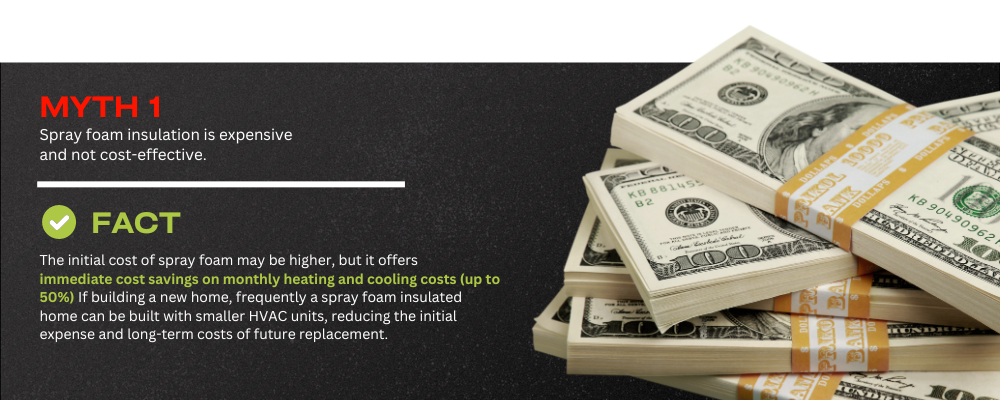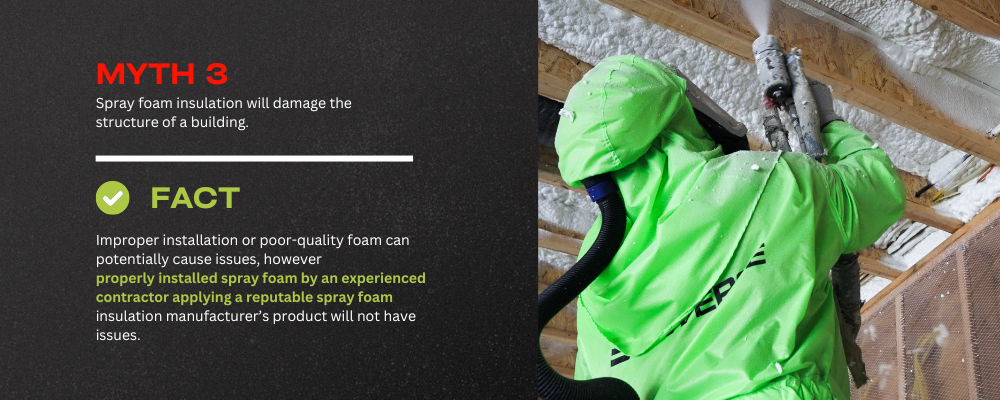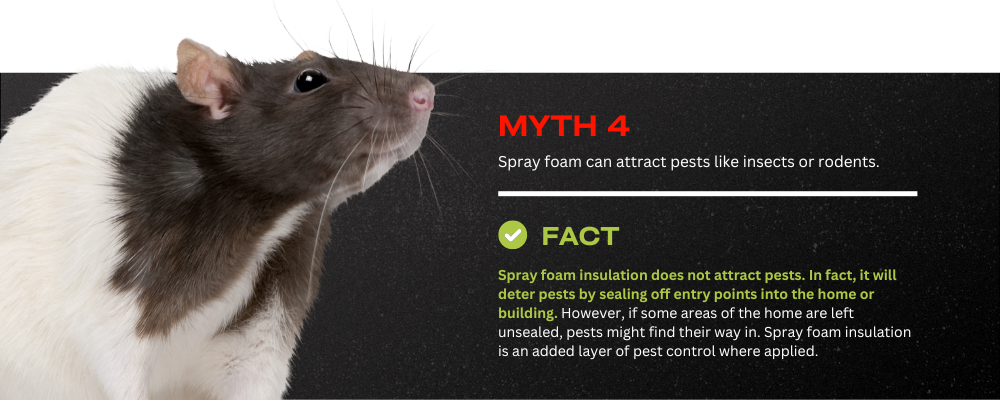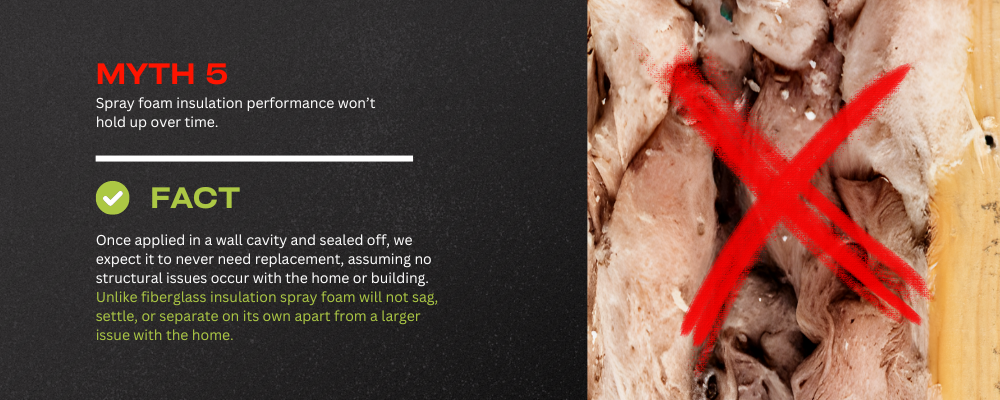Fact: We hear this one all the time. While the initial installation cost of spray foam might be higher than some other insulation types, it offers both immediate cost savings on monthly heating and cooling costs (up to 50%) and reduces the burden on the most costly indoor repair for a home or building owner: the HVAC System. If building a new home, frequently a spray foam insulated home can be built with smaller HVAC units, reducing the long-term costs of future replacement of HVAC units. The long-term costs favor the investment in spray foam insulation.
Spray Foam: Myths vs. Facts
There’s no shortage of myths about spray foam insulation. But, with the right information you’ll be able to see that the benefits of Spray Foam can make a significant improvement in your home. Whether you're looking to renovate your existing home, build a new home, or design a building, don’t let myths about spray foam insulation mislead you and prevent you from creating a more sustainable and comfortable living environment with significant energy savings and higher indoor air quality!
Myth 1: Spray foam insulation is expensive and not cost-effective.


MYTH 2: SPRAY FOAM INSULATION CAN CAUSE HEALTH PROBLEMS.
Fact: When installed correctly, spray foam is not harmful. Most installers recommend homeowners and building occupants vacate for 24 hours post-installation. Once the 24 hours passes and the foam is fully cured, there is no risk to the building occupants. We wouldn’t spray foam insulate any home, let alone our own homes, if we didn’t know it was safe!
MYTH 3: SPRAY FOAM INSULATION CAN DAMAGE THE STRUCTURE OF A BUILDING.
Fact: Improper installation or poor-quality foam can potentially cause issues, however properly installed spray foam by an experienced contractor applying a reputable spray foam insulation manufacturer’s product will not have issues. Additionally, Enverge closed cell spray foam strengthens structures by up to 300% adding rigidity and reinforcement. It’s better for the building structure!!


MYTH 4: SPRAY FOAM INSULATION CAN ATTRACT PESTS LIKE INSECTS OR RODENTS.
Fact: Spray foam insulation does not attract pests. In fact, it will deter pests by sealing off entry points into the home or building. However, if some areas of the home are left unsealed, pests might find their way in. Spray foam insulation is an added layer of pest control where applied.
MYTH 5: Spray foam insulation performance won’t hold up over time.
Fact: Once applied in a wall cavity and sealed off, we expect it to never need replacement, assuming no structural issues occur with the home or building. Unlike fiberglass insulation spray foam will not sag, settle, or separate on its own apart from a larger issue with the home.

Myth 5: Spray foam insulation performance won’t hold up over time.
Fact: Spray foam is very durable. Once applied in a wall cavity and sealed off, we expect it to perform and never need replacement, assuming no structural issues occur with the home or building. However, spray foam insulation could be damaged by homes that settle over time or have foundation issues, which in turn could cause the spray foam insulation to crack or separate. However, Enverge Spray Foam is backed by a limited lifetime warranty because the product will not sag, settle, or separate on its own apart from a larger issue with the home. We proudly stand behind our product.
Myth 6: Spray foam is environmentally unfriendly.
Fact: Spray foam insulation is the most sustainable insulating material to build homes and buildings that are more energy efficient, last significantly longer, and reduce its carbon footprint. Sustainability is at the forefront of everything we do as we formulate Enverge Spray Foam products with low volatile organic compound blowing agents (VOCs) and incorporate both renewable and recycled materials in our products to promote circularity. Enverge also has a U.S.D.A. Bio-Preferred product, SucraSeal, that contains the highest bio-based content, at 17%, among all open cell spray foam insulations in the industry. Spray foam insulation and building better for people and the planet go hand-in-hand.
Myth 7: Spray foam insulation is a fire hazard.
Fact: This is plainly untrue. Spray foam insulation is not a fire hazard. In fact, closed cell spray foams typically meet fire performance code requirements without an intumescent coating and provide the added benefit of increased structural support in the event of a fire. Open cell spray foams that are not Appendix X fire test approved will require an intumescent coating to meet the fire performance codes requirements. Yet Enverge has an open cell spray foam solution for that. Enverge SucraSeal and its sucrose-based formulation deliver an open cell spray foam product that meets fire code performance requirements without having to apply an intumescent coating.
Myth 8: Spray foam absorbs water and cause mold issues under the roof.
Fact: Closed-cell spray foam is water-resistant and will only absorb water if standing water is present over a long period of time. Open-cell spray foam can absorb water, so it's important to avoid its use in areas prone to moisture unless properly protected. Bottom line: spray foam insulation is not meant to do the job of the roof, it’s meant to insulate the building! This is where proper installation and maintenance of the roof is essential to keep the home or building watertight.
Myth 9: Spray foam insulation is a DIY project.
Fact: While there are DIY spray foam kits available, professional installation is recommended to ensure safe and proper application. Proper installation requires specific equipment, knowledge, and expertise. Improper application can lead to poor performance or even structural issues.
Myth 10: Your home or building needs to “breathe.”
Fact: Some people think that a home or building needs to “breathe,” and that spray foam insulation can block its ability to ventilate, leading to a potentially humid indoor climate. However, a home or building is providing the highest quality air and most stable indoor temperatures when it’s sealed and only conditioned air is present. Air flow and humidity levels should be controlled by the HVAC system, and not through cracks and gaps in the walls or windows which can cause an imbalance of temperature as well as allergens, dust, and other airborne contaminants to enter the home.
